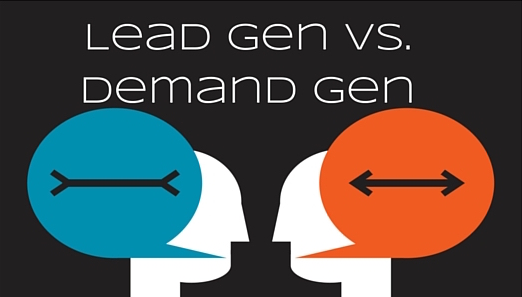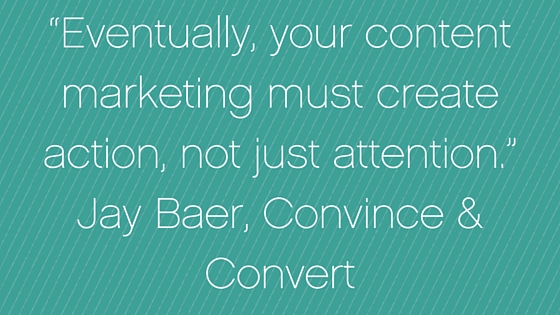Lead gen vs. demand gen: Stop generating confusion
There’s nothing worse than getting someone’s name wrong. And depending on when that offense occurs, catastrophe can take place. That being said, are you using “demand generation” when “lead generation” is what you really mean? If so, your marketing efforts could face catastrophe, too.
Lead gen and demand gen may be sisters from other misters, but they are not one in the same. With proper planning, they can complement each other. But you’ll need to pick a team for each tactic you use — one piece of content can’t achieve both demand gen and lead gen goals.
Before getting too deep on either, here’s the 10,000-foot view:
Demand generation: creates demand for your product or service without collecting any personal information about “leads” or interested parties. Any content is made readily available, without any forms being completed by the prospect.
Lead generation: uses content “offers” (this is HubSpot lingo for anything leads find valuable enough to fill out a form with their contact information in order to download, including e-books, guides, checklists, videos or webinars) or other incentives to obtain email addresses and other lead information, which is added to a customer relationship management (CRM) system for future communication in order to eventually close the sale.
Here’s an overview of the two and how to leverage them.
Demand generation 101
Like the name implies, demand generation is meant to drive interest or awareness for your product or service. Generally, it’s a “shout it from the rooftop” strategy with goals of reaching as many ears and eyeballs as possible, hoping some will turn into sales. Demand gen is more marketing-centric, creating demand for your product or service instead of your content.
Most demand goals are intangible, feel-goody things like:
- Product or service awareness / interest
- Mindshare
- Brand awareness / buzz
- Change in perceptions about your product / service or industry
By “ungating” (e.g. not putting it behind a form) content with broad appeal like videos and e-books, you can make it readily available to essentially anyone. And you can even measure the clicks and downloads.
But here’s the rub: you won’t have the contact information to follow up directly with each lead and send them additional relevant content. You can, however promote it heavily on social media for maximum reach. And still collect some prospect emails with less intrusive “learn more” or “contact us” forms on your sites.
Benefits of demand generation:
- More traffic – attract more traffic to your site or content simply by eliminating the commitment factor of asking prospects for their contact information.
- Social media sharing – without the form barrier, prospects are more likely to share with their own social networks, putting more eyeballs on your content
- Inbound links – the more your content is shared freely, the greater number of inbound links you’ll receive, only adding to your credibility
When demand gen makes sense
There’s a time and place for demand generation tactics. And while it may seem counterintuitive to NOT collect lead intelligence, you have to stay true to your overall goals. Here are a few examples when demand gen is warranted over lead gen:
- Generating buzz or teasing a new product launch
- Shifting perceptions of a product, company or industry
- Minimizing any distractions (like forms and content offers) from prospects who are making an online purchase
One way to ensure the most bang for your demand-gen buck is to create an amazing piece of helpful content on your website or third-party site and implement lead-gen tactics elsewhere on your site, like forms for signing up for a demo.
You’ll probably get tons more eyeballs on your demo or more downloads of your e-book than you would with a strictly lead-gen approach. But what is the next action you want prospects to take?
Truth is, 73 percent of B2B leads simply aren’t ready to buy at the first touch. That’s where lead nurturing comes in.
Say hi to lead gen (where everybody knows your email address)
Lead generation is the process of obtaining leads through content marketing and other efforts. A lead is defined as a visitor or prospect who has gone beyond expressing interest in your product or service, typically through completing a form to access gated content, such as an e-book. Lead gen is more sales-centric, with a goal of creating demand for your content, not your product or service.
The key to lead generation is to create and offer content that is so relevant and helpful that the prospects share an email address or other tidbits of personal info to receive it, knowing damn well you will be contacting them soon.
Lead generation tactics include:
- Gating your whitepaper, webinar, e-book or other content behind a form
- Using a form on your PPC landing page
- Implementing website visitor tracking on your site
- Asking or incentivizing prospects to fill out forms at trade shows and events
- Including email opt-in forms on your website for newsletters and the like
Benefits of lead generation:
- Automation, baby – By having your landing pages, forms and emails doing most of the work for you, there’s no need to hand a lead over to sales until the timing is right.
- Scalability – Because everything is automated, you won’t need a sales army to follow up with your leads — meaning you can promote the hell out of your offer and reach a larger audience without spreading your resources too thin.
- Lasting relationships – Lead nurturing campaigns can span weeks or even months, helping you to stay top of mind and build trust over time.
- Personalization and segmentation – Go beyond “name” and “city” to include any preferences or intel learned through form submissions. With HubSpot’s progressive profiling feature, you can ask (in a non-annoying way) leads for new information every time they return to your site to download another content offer, and segment future offers and communications to make them that much more meaningful.
- Relevance at every step of the buyer’s journey – Create content for the awareness, consideration and decision stages for maximum wins. Don’t neglect middle-of-the-funnel content, where the lead has identified the problem and is considering multiple solutions.
- Smaller audience reach – Much like when you are a reference for someone looking for a job, a smaller audience may seem like a weakness at first, but it’s really a strength, allowing you to talk directly to those more likely to need what you are offering.
- More measurable – When every touchpoint is saved in a CRM system with built-in analytics, it’s much easier to generate dashboards and reports that help measure results.
Lead generation’s sole purpose is to find leads — but not just any will do. They must be qualified. Just ask anyone who’s had the (dis)honor of doing the online dating thing, quantity is not the end goal.
According to a recent Salesforce’s State of Marketing Leadership report, lead quality is the No. 2 concern of marketers. And it should be. What’s the point of attracting leads that are never going to buy from you? Or even worse, are spam?
That’s why metrics are so important. (More on that later, I promise).
There are benefits of using each strategy, or a combo of the two. Before diving into lead gen or demand gen tactics, ask yourself:
- Is my main goal to change perceptions? Create awareness? Start a conversation?
- Does my product or service require a lengthy or high-consideration process?
- Do I need to collect contact information for future communications?
- Does my product require approval from more than one decision-maker?
- What should happen after a content download?
- Am I more interested in volume of visits or attracting leads?
- Which strategy best supports my sales process?
Have any lead or demand gen success stories to share? Hit me up in the comments below.










[…] Do you have more of a demand generation or a lead generation strategy? […]